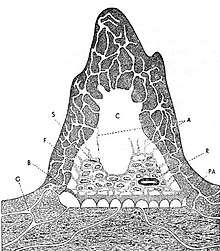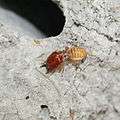Macrotermitinae
Macrotermitinae (fungus-growing termites), is subfamily of Termitidae. Fungus-growing termites species cultivate a fungal genus within Termitomyces for decomposing dead plant material externally within the colony(Note: All termite species decompose organic matter internally with the help of their gut microbiota rather than Macrotermitinae subfamily). Approximately 30 million years ago this subfamily starts to cultivate ancestor of Termitomyces. The real force or reasons to start the fungal domestication is not yet clear. Some gut microbiota based studies indicated that Macrotermitinae subfamily gut composition have close relationship with a cockroach species,[1] both have similar gut microbial composition.[2] This gut microbiota based evidence strongly supported by amber sample which found out an ancestor species of both termites and cockroach.[3] An ant family also cultivate fungus in their colony, known as fungus-growing ants, these ants also shows a similar life style symbiotic life style of fungus-growing termites. Researcher believes that Macrotermitinae is last formed termite groups because of their complex colony life style. For example, over-lapping caste system, age-depended polytheism. Moreover, this subfamily gut composed with bacterial community, rather than flagellates. These fungus growers might be encoded with natural antibiotics because colony does not shows infections so far.
| Macrotermitinae | |
|---|---|
 | |
| Structure of a Macrotermes natalensis mound | |
| Scientific classification | |
| Kingdom: | Animalia |
| Phylum: | Arthropoda |
| Class: | Insecta |
| Order: | Blattodea |
| Infraorder: | Isoptera |
| Family: | Termitidae |
| Subfamily: | Macrotermitinae Kemner, 1934 |
| Genera | |
|
14, see text | |
There are 14 genera which extended to 350 plus species so far in the subfamily.
Colony structure
Macrotermitinae has a complex colony system. A mature Macrotermitinae colony consists of a royal pair, sterile caste, winged reproductive called "alates" and young ones. A royal pair are a king and queen which only can reproduce young ones. Sterile caste are workers (major workers and minor workers) and soldiers (major soldiers and minor soldiers). The royal pair produces workers, soldiers, alates (future royal pairs). The royal pair lives in the "royal chamber", the queen continuous lay eggs and king will mate with her. Young ones are immature workers, soldier and alates, they live in the royal chamber after they hatched. Workers concentrates on colony process, for example collecting dead plant materiel, making fungal comb, brood care, taking care of young ones etc. Soldiers protect the colony.
Distribution
The Macrotermitinae subfamily has a widespread distribution through the tropics of Africa, the Middle East, and southern and southeastern Asia, but it is not present in Australia or the New World.[4] Fossil evidence from Tanzania show that the Macrotermitinae developed agriculture about 31 million years ago.[5]
Ecology
Like other termites, Macrotermitinae are soil engineers, mixing their salivary secretions with soil particles to make their strong, hard mounds and galleries.[6] Their mounds are some of the largest built by any species of termite, with volumes of thousands of litres and lasting for many decades. They are probably the most complex mound colonies of any insect group.[7] There are 11 accepted genera in the Macrotermitinae and about 330 species, with the greatest diversity being in Africa. About 40 species of Termitomyces have been identified as symbionts. In contrast to the fungus-growing ants in the tribe Attini, the Termitomyces often bear fruiting bodies which produce spores, and it is believed that transmission of the fungus to other termites is mainly by horizontal transmission (sibling to sibling) rather than by vertical transmission (mother to daughter). Some species are an exception to this, and in all five species of the genus Microtermes tested, the symbiont fungi did not bear sexual fruiting bodies, and transmission was through the maternal route. Another exception was the single species Macrotermes bellicosus where again the fungus did not fruit, and where transmission was paternal.[7]
They have a rather rigid caste system, with little flexibility after the early instar stage. They also exhibit complex behavioural activities and their presence in an arid or semi-arid area can be dominant over other termite species. As compared to other higher termites however, they show some primitive features and have failed to evolve soil consumption.[6]
The mound contains galleries and chambers in which the termites grow fungi as endosymbionts. The fungi concerned are species of Termitomyces; it is unclear whether one species of termite is always associated with one species of fungus, and it is probable that several species of termite may utilise a single fungal species. The worker termites bring plant material such as dried grass, decaying wood and leaf litter, back to the mound. This material is chewed up and semi-digested by the termites, fertilised with their faeces and placed in the chambers where it is quickly colonised by the fungus to form a "fungus comb". The termites cultivate these fungus gardens, adding more substrate as required, and removing the older parts of the comb for consumption by all members of the colony.[7]
In addition, some species feed on various types of living and dead plant material including wood, but not on decomposing vegetation;[8] these termites have a similar microbial gut flora to other species of termite.[4]
Genera
|
|
Macrotermitinae gut and a cockroach gut
It was hard to explore the gut microbiota of termites, but it suddenly got changed in the last decades, since the introduction of bar-code sequencing strategy.
How a fungus-growing termite colony get originated? (Life cycle of fungus-growing termites)
Winged alates>Colony foundation>First workers>First workers create fungal comb>growth Termitomyces fungus on the comb> Workers gut transfer (dead plat material + fungal spore)> other castes form eventuality> Finally alate formation, they again fly from the colony to form a new colony.
Workers crude plant management system in a mature colony
Old workers>Young workers(Gut passage-fast gut passage)>
Gallery
 A Macrotermitinae mound in the Okavango Delta just outside Maun, Botswana
A Macrotermitinae mound in the Okavango Delta just outside Maun, Botswana A termite soldier (Macrotermitinae) in the Okavango Delta
A termite soldier (Macrotermitinae) in the Okavango Delta An ant of the genus Megaponera with a captured worker termite (Macrotermitinae) in the Okavango Delta, Botswana
An ant of the genus Megaponera with a captured worker termite (Macrotermitinae) in the Okavango Delta, Botswana Worker termites (Macrotermitinae) closing a newly exposed shaft inside a termite mound to prevent the entry of predators
Worker termites (Macrotermitinae) closing a newly exposed shaft inside a termite mound to prevent the entry of predators
References
- Dietrich C, Köhler T, Brune A (April 2014). "The cockroach origin of the termite gut microbiota: patterns in bacterial community structure reflect major evolutionary events". Applied and Environmental Microbiology. 80 (7): 2261–9. doi:10.1128/AEM.04206-13. PMC 3993134. PMID 24487532.
- Otani S, Mikaelyan A, Nobre T, Hansen LH, Koné NA, Sørensen SJ, Aanen DK, Boomsma JJ, Brune A, Poulsen M (September 2014). "Identifying the core microbial community in the gut of fungus-growing termites". Molecular Ecology. 23 (18): 4631–44. doi:10.1111/mec.12874. PMID 25066007.
- DeSalle R, Gatesy J, Wheeler W, Grimaldi D (September 1992). "DNA sequences from a fossil termite in Oligo-Miocene amber and their phylogenetic implications". Science. 257 (5078): 1933–6. PMID 1411508.
- Seckbach J (11 April 2006). Symbiosis: Mechanisms and Model Systems. Springer Science & Business Media. pp. 736–745. ISBN 978-0-306-48173-4.
- Roberts EM, Todd CN, Aanen DK, Nobre T, Hilbert-Wolf HL, O'Connor PM, Tapanila L, Mtelela C, Stevens NJ (2016). "Oligocene Termite Nests with In Situ Fungus Gardens from the Rukwa Rift Basin, Tanzania, Support a Paleogene African Origin for Insect Agriculture". PLOS One. 11 (6): e0156847. doi:10.1371/journal.pone.0156847. PMC 4917219. PMID 27333288.
- König H (2006). Intestinal Microorganisms of Termites and Other Invertebrates. Springer Science & Business Media. p. 202. ISBN 978-3-540-28180-1.
- Aanen DK, Eggleton P, Rouland-Lefevre C, Guldberg-Froslev T, Rosendahl S, Boomsma JJ (November 2002). "The evolution of fungus-growing termites and their mutualistic fungal symbionts". Proceedings of the National Academy of Sciences of the United States of America. 99 (23): 14887–92. doi:10.1073/pnas.222313099. PMC 137514. PMID 12386341.
- Wood TG (1978). "Food and Feeds Habits of Termites". In Brian MG (ed.). Production Ecology of Ants and Termites. Cambridge University Press. p. 56. ISBN 978-0-521-21519-0.
| Wikispecies has information related to Macrotermitinae |